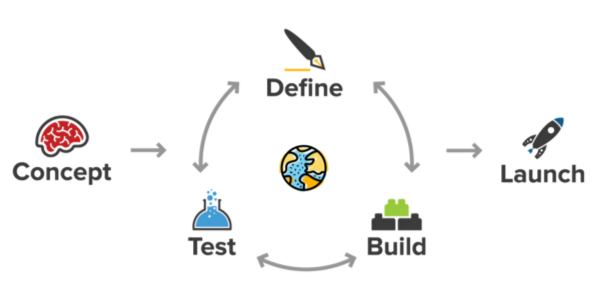So, you have a Start-Up idea, what should you do next?
The first step in launching a successful startup is to create a Minimum Viable Product (MVP). An MVP helps to prove that there is a target market where you can sell your product. This means that before investing in development and searching for an expert team, you should find your first clients and understand what features they are ready to pay for.
A minimum viable product (MVP) is a version of a product with just enough features to satisfy early customers and provide feedback for future product development.
— Eric Ries
However, most entrepreneurs don’t usually think of the MVP creation process and confirming the fact that their ideas solve critical problems for people who are ready to pay. So, an entrepreneur can finally stop on an idea, just after validating its viability with doubtful comments of first users or biased opinions of authors.
People lie to themselves in order to give you the possibility to hear what you want to hear. We are all human beings. It happens more often than we can imagine. Just google “the list of cognitive biases” to get proof.
In the process of defining whether your idea is profitable or not, there are several totally wrong approaches to the question: some of them are too self-confident, others almost ideal, but only if there are skills and resources. Anyway, there is one key point — a dialogue with the target market.

MVP lifecycle
Source: Mitch Robinson, Medium
The ways of idea validation can be hierarchically divided into the following categories: flawed, situational, and ideal testing methods. Let’s review some examples below.
Flawed Testing
Surveys
When you conduct surveys and ask your friends what they think of your idea, it usually results in asking a list of leading questions and hence getting inadequate feedback because of bias. You may think, “Why would they mislead me?” Sometimes people are just scared to share their true opinion and get sincere feedback. It happens because many amateur businessmen are so enchanted by their ideas that they search for any justifications to continue developing it. If you ask your friends for advice, they will probably approve of any your idea. And you are likely to interpret any data you get in such a way so as to confirm your beliefs.
Product development
Realizing ideas on an early startup stage may seem a wonderful action only if you’re a talented engineer and can create something very quickly. This way you can develop a product without being sure about the viability of your idea. It’s a dangerous method that has become a reason for the mass failures of tech startups in the 90s.
Now we know that the “create a product and customers will come” philosophy doesn’t work. Instead, you should follow the idea of “creating something that people need”.
Situational testing
Audience growth
A pre-building audience with the help of a blog or an email subscription service is a great method if you’re going to start a company in a niche market, create a reputation, or understand your target audience better. There’s a powerful tool by Klout if you need to get data for social networks analysis, or you don’t have a technical background and want to make sure that the audience is interested in the concept.
It will also let you interact with the market and learn about the problems and disappointments of your potential clients, which is the best indicator of a product they would gladly pay for.
Reach out to potential clients
No matter what approach you choose, you should communicate with clients. But a thorough market investigation and product creation may lead to ambiguous results if they aren’t carried out properly (many people don’t even try to create a full-fledged MVP).
If you consider yourself a born leader, it may happen that you will constantly try to chase “one more big goal” and finally you’ll have 3-4 attempts to create something big. Still, none of them will ever develop into something serious, as you will again be distracted by another major problem.
It’s also very important to concentrate on what people are ready to pay for instead of searching for new problems. If you are going to interview many people about your MVP-strategy, use this opportunity to consult them at the end of your conversation. There’s a chance that you’ll learn about really annoying problems and indeed valuable solutions for which your potential customers are ready to pay.
Quick rollout of a simple product
Creating a prototype as quickly as possible isn’t a bad idea if you understand your market and have carried out a thorough investigation. Nonetheless, a majority of people (especially beginner entrepreneurs) conclude that they know what people want.
It means that you create a product that solves a problem that you detected based only on your experience and professionalism. The problem is that we all have egos that speak inside us, and we create solutions that we would like to see instead of the one necessary for thousands of clients. It’s quite a dangerous approach as it pushes founders to create something without constant feedback. Nevertheless, if you can quickly let customers try your product and tweak it based on the feedback you get, you’re on the right way.
Crowdsourcing
Kickstarter and other crowdfunding platforms allow users to pre-purchase a product, which is a great source of money for initial orders. There can be a problem with MVP: as an interaction cycle is quite long, it means that you’re linked to one and the same prototype for a month and even longer. MVP should be updated constantly, but the majority of crowdfunding platforms hinder it.
There are several product categories for which crowdsourcing works fine. Pebble watch is probably the best result of such an approach, and other successful examples also concern hardware. The approach works great for developing similar gadgets – it helps to get necessary financing for creating a physical product that you won’t get in other places.
Ideal testing
Content Marketing
Landing pages are perfect if you’re looking for financing. Although you can’t earn money without delivering a product, you still can ask for funding. How? Quite easily: display all the items as “sold out” when a person tries to buy them and simultaneously make a list of those who are ready to buy them. If you can start shipping the product to your audience during a short period of time (you’d better do it in 2 weeks), then you’re in. It’s a powerful and the best proof for the correctness of your concept than anything else.
Hollow-MVP
Be prepared to listen when people give off subtle signals. Read between the lines. Ask for money because it’s the best way to get useful information, not because you want money.
— Dan Shipper
Such a product may seem a full product but with a “hollow” back-end. Such an approach is great for non-technical founders searching for a robust proof of concept. Here are some examples:
- ZeroCater, in the beginning, had only a big spreadsheet and tried to connect companies with restaurants.
- Groupon launched just a WordPress blog at first and manually sent PDF vouchers.
- Grouper, one more Y Combinator company, started their operations with just a spreadsheet trying to match groups of people on dates.
Quick development
If you’re a founder of a technological startup, this is what you should do. The key thing here is to understand the problems of your target audience and create a product that motivates your early adopters to pay. It’s essential to find a balance between the desired product and a working one.
Minimum Desirable Product is the simplest experience necessary to prove out a high-value, satisfying product experience for users.
— Andrew Chen
Concierge MVP
A successful strategy of Netflix was to deliver a product as a service.
Netflix started in California by two men by the names of Reed Hastings and Marc Randolph. Hastings had to pay a huge late fee for a movie he rented, and it was then that it came to him the idea of the mail-order rental movies with no late fees.
— Funding Universe
Then they started renting movies to their friends. That’s how Netflix was born. It may seem evident, but if you ask the majority of entrepreneurs how they would start their own Netflix today, you’ll get very detailed technological answers. Start doing something by hand until you can widen your business.
Profit and growth
This approach builds up the knowledge and experience acquired by selling something created earlier and for which a strong market is available. Due to such a method, an entrepreneur gets an audience and can quite easily check his idea on the condition of the right promotion. After this, a strategy can be changed, and you can start selling anything no matter what your company was selling earlier.





